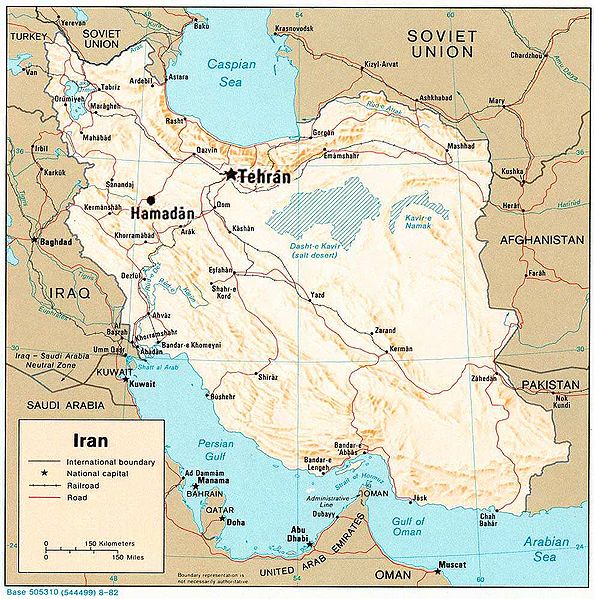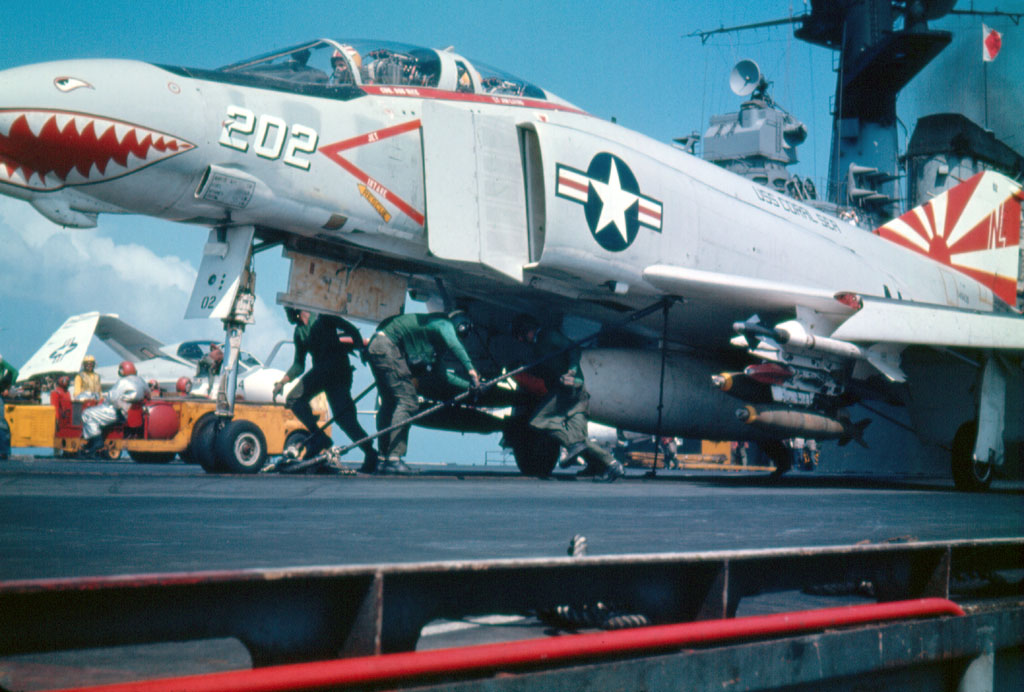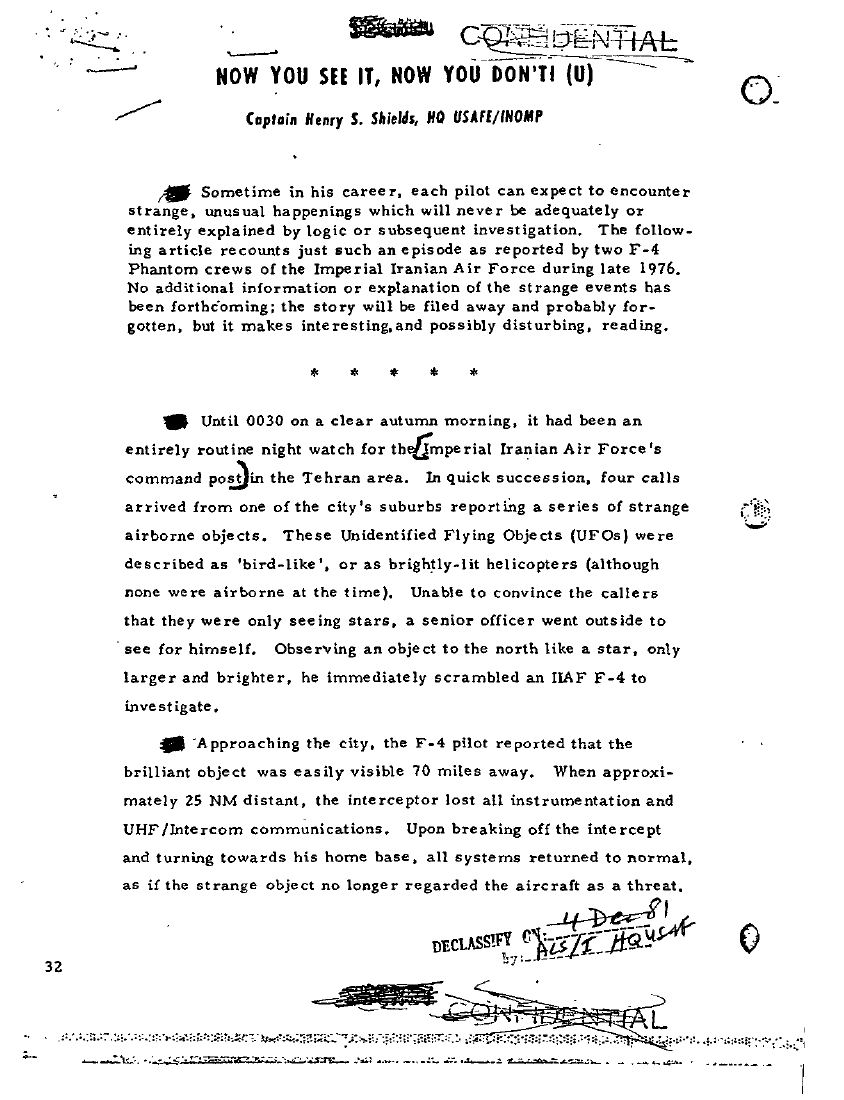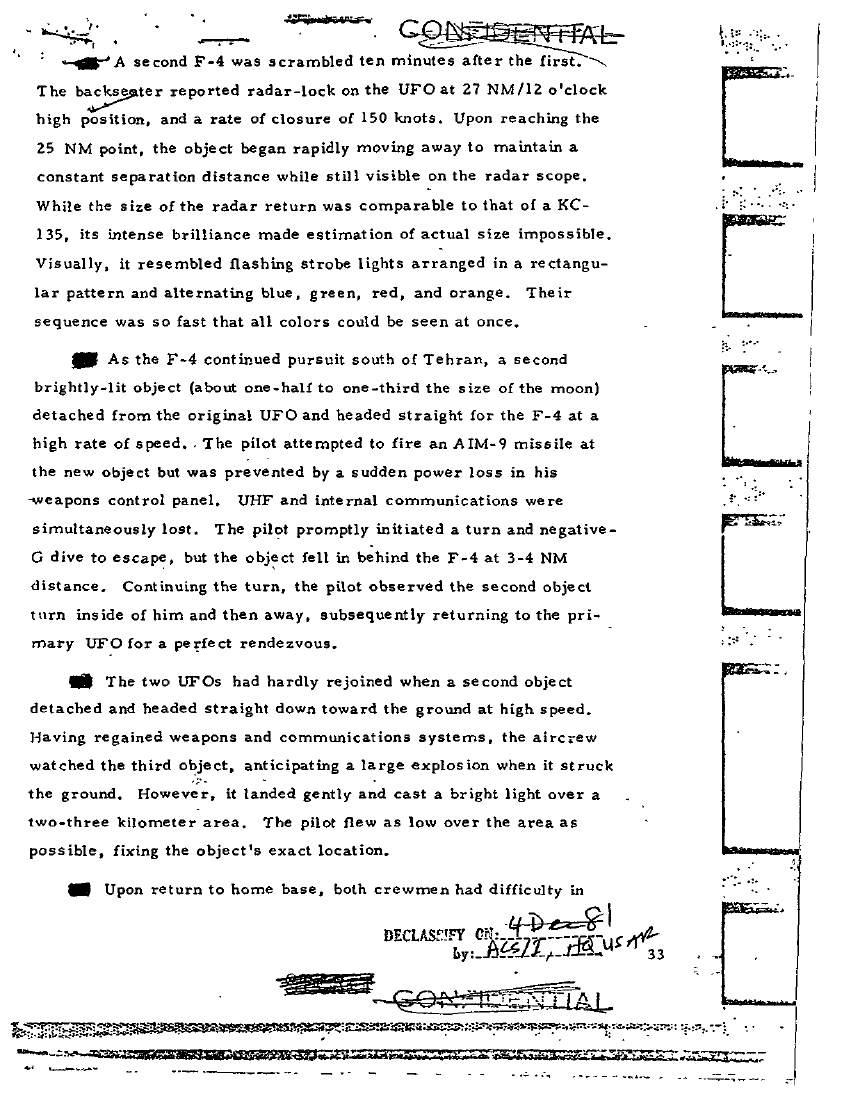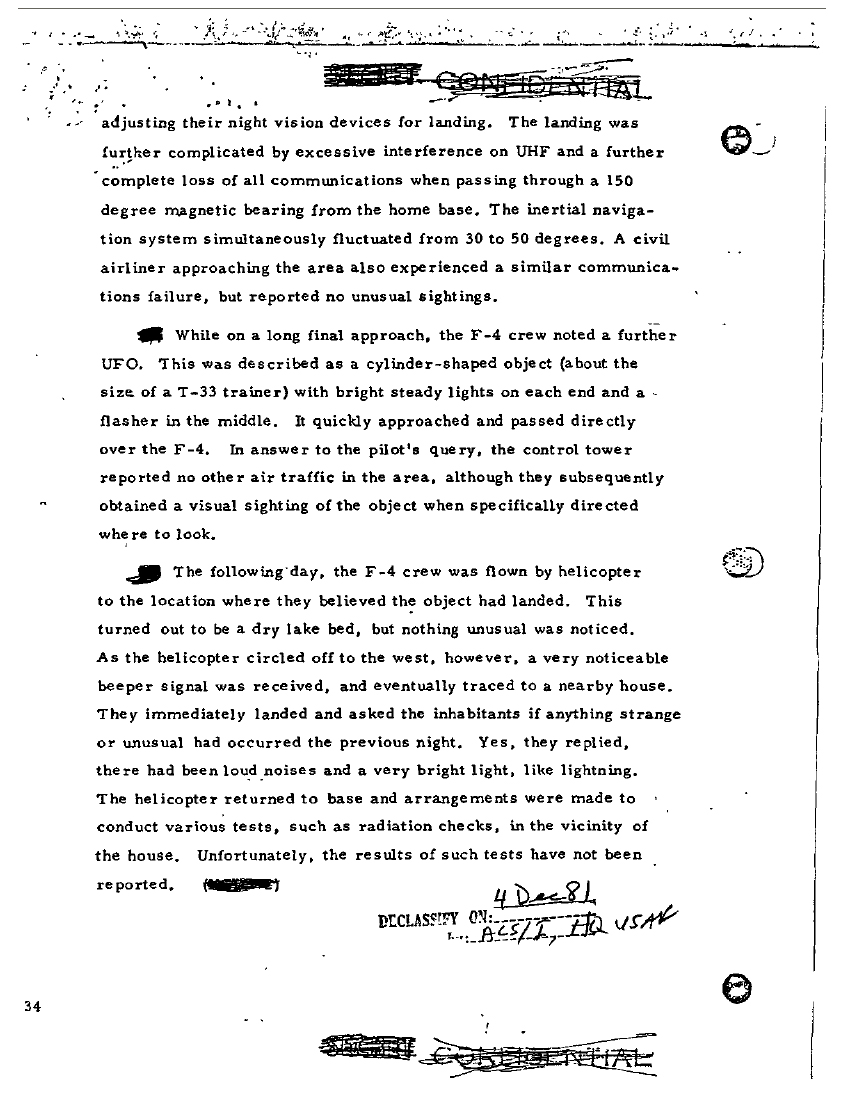|
The UFO Files Reports |
|||||
Video presentation by Lady Kylie on Youtube May 27, 2009 |
|||||
where two F-4 jet interceptors were launched. Credit: 1982 CIA political map of Iran The 1976 Tehran
UFO Incident was a radar and visual
sighting of an unidentified flying object (UFO)
over Tehran, the capital
of Iran, during the early morning hours of
September 19, 1976. The incident
is particularly notable for the electromagnetic
interference effects observed
on aircraft in close proximity to the object: two
F-4 Phantom II jet interceptors
independently lost instrumentation and
communications as they approached,
only to have them restored upon withdrawal, and
one of the aircraft also
suffered temporary weapons systems failure while
preparing to open fire.
The incident is well-documented in an U.S. Defense
Intelligence Agency
(DIA) report with a distribution list that
included the White House, Secretary
of State, Joint Chiefs of Staff, National Security
Agency (NSA), and Central
Intelligence Agency (CIA). Various high-ranking
Iranian military officers
directly involved with the events have also gone
on public record stating
their belief that the object was not terrestrial
in origin.
The incident: At approximately 12:30 AM local time (2100Z), September 19, 1976, over Tehran, Iran, the Imperial Iranian Air Force command post at Tehran received four reports by telephone, from civilians in the Shemiran city district, of unusual activity in the night sky. Some of the callers reported seeing a bird-like object, while others reported a helicopter with a bright light. When the command post found no helicopters airborne to account for the reports, they called General Yousefi, assistant deputy commander of operations. General Yousefi at first said the object was only a star, but after conferring with the control tower at Mehrabad International Airport and then looking for himself to see a very bright object larger than a star, he decided to scramble one F-4 Phantom II jet fighter from Shahrokhi Air Force Base in Hamadan, approximately 175 miles (280 km) west of Tehran. (for location see map at right) At 0130 hours (2200Z), the F-4 was launched and proceeded to a point 40 nautical miles (74 km) north of Tehran. It was noted that the object was of such brilliance that it could be seen from 70 miles (110 km) away. When the aircraft approached to approximately 25 nautical miles (46 km) from the object, the jet suddenly lost all instrumentation and communications capabilities, prompting the pilot to break off the intended intercept and turn back toward Shahrohki; upon the evasion, both systems resumed functioning.
A McDonnellDouglas F-4B Phantom
II (BuNo 149430) of fighter squadron VF-111
Sundowners about to be launched
from the aircraft carrier USS Coral Sea
(CVA-43) during a deployment to
Vietnam in 1971/72. The F-4B is armed with
AIM-9D Sidewinder missiles and
Mk 82 (500 lb/227 kg) bombs. The relatively
small weapons load was typical
for Coral Sea due to the limited catapult
capacity. Source: www.usscoralsea.net
At 0140 hours, a
second F-4 was scrambled, piloted by
Lieutenant Parviz Jafari. Jafari would eventually
retire as a general and
participate on November 12, 2007, at a National
Press Club conference demanding
a world-wide investigation into UFO phenomena. [1][2][3][4][5]
(see also below)
Jafari's jet had acquired a radar lock on the
object at 27 nautical miles
(50 km) range. The radar signature of the UFO
resembled that of a Boeing
707 aircraft. Closing on the object at 150
nautical miles (280 km) per
hour and at a range of 25 nautical miles (46 km),
the object began to move,
keeping a steady distance of 25 nautical miles (46
km) from the F-4. The
size of the object was difficult to determine due
to its intense brilliance.
The lights of the object were alternating blue,
green, red, and orange,
and were arranged in a square pattern. The lights
flashed in sequence,
but the flashing was so rapid that they all could
be seen at once.
While the object and the F-4 continued on a southerly path, a smaller second object detached itself from the first and advanced on the F-4 at high speed. Lieutenant Jafari thinking to be under attack, tried to launch an AIM-9 sidewinder missile, but he suddenly lost all instrumentation, including weapons control, and all communication. The F-4 pilot then instituted a turn and a negative G dive as evasive action. The object fell in behind him at about 3 to 4 nautical miles (7.4 km) distance for a short time, then turned and rejoined the primary object. The main object then flew away at several times the speed of sound, according to a voice tape from one of the pilots. Once again, as soon as the F-4 had turned away, instrumentation and communications were regained. The F-4 crew then saw another brightly lit object detach itself from the other side of the primary object and drop straight down at high speed. The F-4 crew expected it to impact the ground and explode, but it came to rest gently. The F-4 crew then overflew the site at a decreased altitude and marked the position of the light's touchdown. Jafari would later comment that the object was so bright that it lit up the ground and he could see rocks around it. Then they landed at Mehrabad, noting that each time they passed through a magnetic bearing of 150 degrees from Mehrabad, they experienced interference and communications failure. A civilian airliner that was approaching Mehrabad also experienced a loss of communications at the same position relative to Mehrabad. As the F-4 was on final approach, they sighted yet another object, cylinder-shaped, with bright, steady lights on each end and a flashing light in the middle. The object overflew the F-4. Mehrabad tower reported no other aircraft in the area, but tower personnel were able to see the object when given directions by the F-4 pilot. Years later, the main controller and an investigating general revealed that the object also overflew the control tower and knocked out all of its electronic equipment as well (see below). The next day, the F-4 crew flew out in a helicopter to the site where they had seen the smaller object land. In the daylight, it was determined to be a dry lake bed, but no traces could be seen. They then circled the area to the west and picked up a noticeable "beeper" signal. The signal was loudest near a small house, so they landed and questioned the occupants of the house about any unusual events of the previous night. They reported a loud noise and a bright light like lightning. Further investigation of the landing site, including radiation testing of the area was apparently done, but the results were never made public. Since this event occurred before the fall of the Shah, any records in Tehran itself may be lost. Alongside the report there was a form from the DIA which assessed the quality of the report. The form indicated in checked boxes that the content was of high value, that the report was confirmed by other sources, and that the utility of the information was potentially useful to them. The form from the DIA also stated the following: "An outstanding report. This case is a classic which meets all the criteria necessary for a valid study of the UFO phenomenon: Opinions of some participants In 1994, Sightings TV program tracked down and interviewed various principals involved in the incident. Nearly all expressed the opinion that they were dealing with a high-technology extraterrestrial craft. [6] One of the pilots of the first jet interceptor, Yaddi Nazeri, estimated that the UFO was traveling somewhere between two and three thousand miles per hour. He said that the object "...was beyond my speed and power. The [later] F-4... also could not catch up to the object. That's when I thought, this is a UFO." Nazeri added that "...no country had this type of flying object, so I was thinking, this craft is from another planet." The second F-4 pilot, General Parviz Jafari, said that after trying to fire a missile and failing, they feared for their lives and tried to eject, but the eject button also malfunctioned. [7] At a Washington D.C. press conference on November 12, 2007, Jafari added details that the main object emitted four objects, one which he tried unsuccessfully to fire on, another which followed him back, and one which landed on the desert floor and glowed. Following his prepared statement at the press conference, Jafari was asked if he believed he had encountered an alien spacecraft and Pirouzi said he was quite certain that he had. (see below for further details and references) General Nader Yousefi, the assistant deputy commander of the Iranian Air Force, said he ordered the two jet interceptions. He said that, "Because of the experience I had on September 19, 1976, I believe there is something up there. We just don't know what it is or where it came from." Yousefi repeated many of the details of the encounter already recorded in the DIA document but also added a few more. Yousefi said that after the second F-4 lost its communications and weapons systems and took evasive maneuvers, it tried one last pursuit of the UFO. Even approaching at Mach 2, the UFO easily outdistanced it. The pilots decided to return to Mehrabad airport. As they were approaching to land, Yousefi said the control tower phoned him that the UFO was following the jet back to base. The control tower supervisor, Hossein Pirouzi, told Sightings that the pilot was in a panic with the large UFO on its tail. According to Pirouzi and other controllers, the UFO performed a low-altitude flyby over Mehrabad at about 2200 to 2,500 feet (760 m). It was described as a cylinder-shaped object as large as a tour bus, with bright steady lights on each end and a flasher in the middle. During the flyby, the control tower lost all power, although other parts of the airport were unaffected. After the flyby, the UFO took off to the west and was spotted 25 minutes later over the Mediterranean by an Egyptian Air Force pilot, then again over Lisbon, Portugal by the pilot, crew, and passengers of a KLM Airlines flight, reporting that it was speeding westward over the Atlantic Ocean. The following day, an investigation was held in Tehran. The Iranian Air Force Deputy Commander, Lieutenant General Abdollah Azarbarzin, conducted interviews with all of the principals and wrote up a report. Gen. Jafari, the second F-4 pilot, stated that he was among those interviewed and an American colonel sat there and took notes. This information later appeared in the D.I.A. account of the incident. Tower controller Pirouzi was also among those interviewed. He recalled a discussion by Azarbarzin's panel at the conclusion of the meeting. "When they heard our report and the report of the pilots, they concluded that no country is capable of such technology, and all of them believed it was a strange object from outer space." [8] When interviewed by Sightings, Azarbarzin independently confirmed Pirouzi's statement. He said they concluded that the UFO had deliberately jammed both the aircraft and control tower electronics. About the objects that seemed to shoot out of the UFO, Azarbarzin said, "The pilots called them fireballs, but we all thought that they were very powerful waves of electromagnetism, which jammed all the electronics starting from VHF, UHF, fire control system, gun radar, gun communications, everything. Everything was gone." Azarbarzin also said that the copilot got a good look at the UFO when the second F-4 came out of its emergency dive and passed underneath it. He told both Sightings and researcher Dr. Bruce Maccabee the copilot could see the shape, which he said was round like a plate or just like a saucer, with a canopy or cockpit that looked like half a ball bathed in a dim orange or yellowish light, but with no visible crew. [9] When all factors were considered, including the extraordinary rate of acceleration displayed by the UFO, Azarbarzin concluded that the UFO had outperformed any known human aircraft. This conclusion was relayed to General Hatemi, the Shah's personal military advisory, who instructed Azararzin to give his report to the U.S. Military Assistance Advisory Group in Tehran (MAAG). In charge of MAAG and chief U.S. Air Force military advisory to the Iranians was General Richard Secord. Secord declined to be interviewed. Gen. Azarbarzin refused to state publicly whether Secord had seen the report, but another high Iranian Air Force commander, Mamoud Sabahat, told Sightings that he was present in Tehran to attend a meeting on the night of the incident. "This UFO event was the first time in our Air Force's history that anything had happened like this. It would have been a usual and customary part of the military system to put him [Secord] at that meeting." Gen. Azarbarzin also told Maccabee that the complete records of the investigation had been turned over to the U.S. Air Force. However, the USAF has steadfastly maintained that their only record of the incident was provided in the DIA document originally prepared by a USAF officer who interviewed the pilot of the second F-4. About his personal opinion, Gen. Azarbarzin told Sightings, "I believe in UFOs. I cannot ignore their existence. They want to find some way of contacting the people of earth. They are trying, and they are going to do it." Azarbarzin's opinion was echoed by Amir Kamyabipour, former deputy commander of operations in the Iranian Air Force. Because of what he experienced first-hand during this incident, he believes, "UFOs are trying to find some way to make contact with our world. I am positive of this."
In the October 1, 1976 issue of the Iran Times from Washington, D.C., an apparent firsthand account from Lt. Jafari, the pilot of the second jet interceptor, was published, based on a tape of the actual pursuit. The aircraft flew towards Tehran at over the speed of sound. Jafari "said that on seeing him coming, the UFO increased its speed. 'It was half the size of the moon as seen from earth,' he said. 'It was radiating violet, orange, and white light about three times as strong as moonlight.'" Jafari was ordered to return to base if was unable to get near, and Jafari cut off pursuit. As he was returning, he "told air controllers that the UFO had doubled back on its pursuers, and he was in danger of being forced down. 'Something is coming at me from behind. ...I think it is going to crash into me. It has just passed by, missing me narrowly...' The disturbed voice of the pilot was clear on the tape." [10] The article also recounted how the pilot spoke of a "bright round object, with a circumference of about 4.5 meters, leave the UFO." It also said that the authenticity of the object had already been confirmed by the two F-4 pilots, several control tower operators, and witnesses on the ground who reported a "bright body" flit across the sky while others reported seeing "some bright thing" fall from the sky. Another document later came to light revealing that a very similar UFO was sighted in Morocco from many locations about 3 to 4 hours later, or 0100 to 0200 hours local time on September 19. The document was from the American embassy in Rabat, Morocco to the U.S. State Department, dated September 25, 1976--"Subject: Request for Info. Unidentified Flying Objects." It recounted that the Moroccan police had received numerous reports of an object generally flying parallel to the Atlantic coast at low altitude. It had a silvery luminous circular or tubular shape and was giving off intermittent trails of bright sparks and fragments. It made no noise. One of the embassy's unnamed briefers said he had seen it himself, and that it appeared to be traveling slowly like an aircraft preparing to land. At first it appeared disc-shaped, but took on a tubular appearance as it got closer. Secretary of State Henry Kissinger responded ten days later and took the official U.S. policy line on UFOs. Kissinger claimed the Condon Committee report had shown that all UFOs could be attributed to natural causes and no further study was warranted. Kissinger said people had probably seen a meteor or a decaying satellite part for which there was no re-entry record. [11] In a search for further information on the case in National Security Agency records, it was also found that an article on the Tehran incident had been written in 1978 (see Gallery) in the classified MIJI Quarterly a periodical published by the Electronics Security Command at San Antonio, Texas. The journal contained narrative summaries of all electronic warfare "meaconing," "intrusion," "jamming," and "interference" incidents (hence the acronym MIJI--see [1]). The report basically provided the details in the DIA document, but prefaced the article as follows: "Sometime in his career, each pilot can expect to encounter strange, unusual happenings which will never be adequately or entirely explained by logic or subsequent investigation. The following article recounts just such an episode as reported by two F-4 Phantom crews of the Imperial Iranian Air Force during late 1976. No additional information or explanation of the strange events has been forthcoming: the story will be filed away and probably forgotten, but it makes interesting, and possibly disturbing, reading." [12] Skeptical explanation and analysisIn his book UFOs:
The Public Deceived, debunker
Philip J. Klass claimed the witnesses initially
saw an astronomical body,
probably Jupiter, and pilot incompetence and
equipment malfunction accounted
for the rest.
Although Jupiter was by far then the brightest astronomical object in the sky (except for a rising crescent moon), it is not possible for it to have been the object that the F-4's were directed to or chased. The bright object was first noticed by witnesses in Shemiran, the northernmost district of Tehran. One of the witnesses in the northeastern part of Tehran was Gen. Yousefi himself, who ordered the jet interceptions. The jets were scrambled from Shahrokhi AFB in Hamadan, about 175 miles (282 km) west-southwest of Tehran, and vectored to a point 40 miles (64 km) north of central Tehran. However, Jupiter was in the east. Thus the UFO was approximately 90 degrees away from Jupiter at the time. In addition, the second F-4 chased the UFO from northern to southern Tehran. Again, Jupiter would be at nearly 90 degrees to the pursuit trajectory. Furthermore, both F-4's picked up and tracked something on their radar, impossible for an astronomical object like a star or planet. Many more details of the encounter do not match Klass' proposed explanation, such as both F-4's and the control tower losing their electronics with close approach to the UFO and a third civilian plane in the region also losing communications. Jerome Clark commented, "Klass's theory presumes a remarkable lack of even rudimentary observing and technical skills on the parts of the Iranian participants. In some ways it would be easier to credit the notion, for which no evidence exists either, that the witnesses consciously fabricated the sighting. Both Gen. Azerbarzin and air controller Perouzi considered the incident thoroughly puzzling. So, as the documents indicate, did American analysts familiar with it." [13] The incident is regarded by a number of UFO researchers to be one of the premier UFO encounters ever recorded. Some researchers consider it strong evidence for the extraterrestrial origins of the UFO because there was a blackout on the F-4 just when it was going to fire and because of instrumental breakdowns on two different aircraft while they were on the chase. A military spy satellite also recorded this incident. The DSP-1 satellite detected an infrared anomaly during the time of this event that lasted for about an hour. [14]
1978 Tehran UFO incidents A somewhat similar UFO incident over Tehran occurred in 1978, again involving electromagnetic interference and U.S. DIA interest. The report was sent by the U.S. Defense Attache's office to the Joint Chiefs of Staff, part of the normal routing for foreign intelligence reports. As in the 1976 case, the distribution list included the Secretary of State, the NSA, and the CIA. The report was quoted from the Iranian English-language newspaper Tehran Journal, dated July 18, 1978. The article said that a UFO had been seen by a number of people on the night of July 16, again in the northern part of Tehran. One witness said he saw the object suddenly emerge in the sky and hover directly above him. Witnesses said it was a "strange glowing object" that seemed to be floating southwestward toward Saveh (about halfway between Tehran and Hamadan). Witnesses contacted the National Radio Network and the control tower at Mehrabad, which confirmed the existence of the object but provided no further details. The article added, "Officials from the control tower at Mehrabad Airport and a Lufthansa aircrew also reported unusual readings on their instruments." The article also briefly mentioned another recent UFO incident from April 1978. A local pilot said that he and his copilot had photographed a "glittering" object while flying between Ahvaz and Tehran. (Ahvaz is about 200 miles (320 km) southwest of Tehran.) He could not release the photographs until the security devision of the civil aviation authorities gave permission. Apparently there was also ground radar corroboration. "A Mehrabad radar control official said that on that occasion they had detected an object some 20 times the size of a jumbo jet on their screens." Civil aviation authorities were said to be investigating, but the results had not been made public. [16]
Credit: United States Air Force, Captain Henry S. Shields |
|||||
|
See also: References:
Related links:
Papers:
|
|||||

Imperial Iran
Air Force
Declassified Defense Intelligence Agency documents released under the Freedom of Information Act reveal that on 19 September, 1976, an unusual incident occurred over Tehran, Iran. At about 0030 hours, the Imperial Iranian Air Force command post at Tehran received four telephone reports from citizens in the Shemiran (north of Tehran). Some of the callers reported seeing a bird-like object in the sky, while others reported a helicopter with a bright light. When the command post found that there were no helicopters airborne at that time, they called General Yousefi, assistant deputy commander of operations. General Yousefi at first said the object was only a star, but after talking to the tower at Mehrabad Airport, he looked for himself and saw a very bright object larger than a star. At that point he decided to scramble one F-4 Phantom jet from Shahrokhi Air Force Base in Hamadan. At 0130 hours, the F-4 took off and proceeded to a point 40 nautical miles north of Tehran. It was noted that the object was of such brilliance that it could be seen up to 70 miles away. When the F-4 came to within about 25 nautical miles of the object, the jet suddenly lost all instrumentation and communications. The pilot broke off the intercept and turned away. When the F-4 had turned back toward Shahrokhi, the aircraft regained instrumentation and communication. At 0140 hours, second F-4 was scrambled, piloted by Lieutenant Jafari and it acquired a radar lock on the object at 27 nautical miles range. The radar signature of the UFO resembled to that of Boeing 707 aircraft. Closing on the object at 150 nautical miles per hour. At a range of 25 nautical miles, the object began to move, keeping a steady distance of 25 nautical miles from the F-4.The size of the object was difficult to determine due to its intense brilliance. The lights of the object were alternating blue, green, red, and orange, and were arranged in a square pattern. The lights flashed in sequence, but the flashing was so rapid that they all could be seen at once. As the object and
the F-4 continued on a southerly
path, a smaller second object detached itself from
the first and advanced
on the F-4 at a high rate of speed. Lieutenant
Jafari thinking to be under
attack, he launch an AIM-9 sidewinder missile, but
he suddenly lost all
instrumentation, including weapons control, and all
communication. The
F-4 pilot then instituted a turn and a negative G
dive as evasive action.
The object fell in behind him at about 3 to 4
nautical miles distance for
a short time, then turned and rejoined the primary
object.
The next day, the F-4 crew flew out in a helicopter to the site where they had seen the smaller object land. In the daylight, it was determined to be a dry lake bed, but no traces could be seen. They then circled the area to the west and picked up a noticeable "beeper" signal. The signal was loudest near a small house, so they landed and questioned the occupants of the house about any unusual events of the previous night. They reported a loud noise and a bright light like lightning. Further investigation of the landing site, including radiation testing of the area was apparently done, but the results were never made public. Since this event occurred before the fall of the Shah, any records in Tehran itself may be lost. The Defense
Intelligence Agency itself called this
report:
One of the most interesting things about this event is that it was apparently detected by a military spy satellite. This satellite, the DSP-1, was launched to warn of ballistic missile launches by detecting infrared heat sources. It was used to detect SCUD missile launches during Desert Storm. An analysis of computer printouts from DSP-1 by researchers Lee Graham and Ron Reghr, of Aero-Jet in California, shows that it definitely detected an infrared anomaly over Tehran at the time of the UFO event reported above. Source: Imperial Iran Air Force |
|||||
| FAIR USE NOTICE: This page contains copyrighted material the use of which has not been specifically authorized by the copyright owner. Pegasus Research Consortium distributes this material without profit to those who have expressed a prior interest in receiving the included information for research and educational purposes. We believe this constitutes a fair use of any such copyrighted material as provided for in 17 U.S.C § 107. If you wish to use copyrighted material from this site for purposes of your own that go beyond fair use, you must obtain permission from the copyright owner. | |||||
|
|
